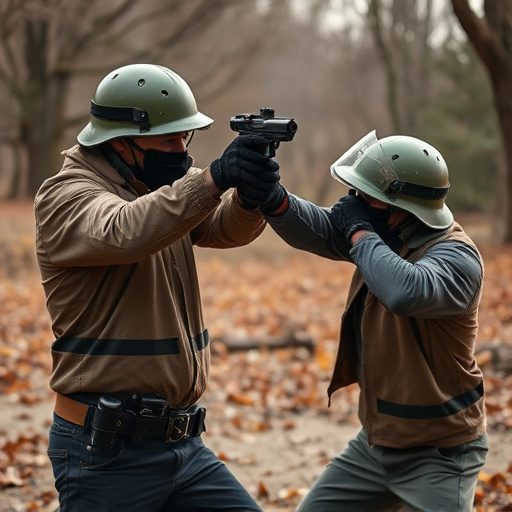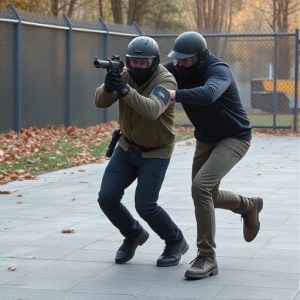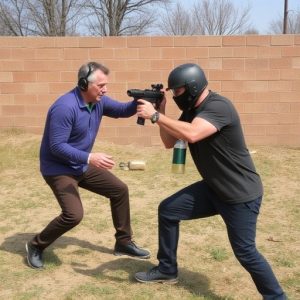Taser vs Stun Gun: Comparing Police-Grade Options for Law Enforcement
Police-grade stun guns and Tasers are non-lethal weapons with distinct incapacitation methods. Stun…….
Police-grade stun guns and Tasers are non-lethal weapons with distinct incapacitation methods. Stun guns emit high-voltage shocks, while Tasers use electrical pulses to disrupt muscle control. Stun guns cater to civilians for self-defense, offering various power levels, size options, and advanced features like LED lights or laser sights. Police-grade stun guns are designed for professionals with durable construction and precise control. Both tools require proper training, understanding local laws, and adhering to safety guidelines for effective and legal deployment. When considering police-grade stun gun options, factors include voltage, weight, energy output, and optional extras.
In the realm of personal safety and law enforcement, Tasers and stun guns stand as powerful tools, yet they differ significantly. This article delves into the minutiae of these devices, offering a comprehensive guide for users. We begin with a basic overview, exploring their mechanisms and applications. Subsequently, we dissect the features and considerations of police-grade stun guns, analyze Taser technology, evaluate stun gun effectiveness, and examine legal implications. By comparing these tools, we aim to provide insights into the optimal choice for law enforcement agencies, shedding light on the diverse police grade stun gun options available.
- Understanding Tasers and Stun Guns: A Basic Overview
- Police Grade Stun Guns: Key Features and Considerations
- Taser Technology: How It Works and Its Advantages
- Stun Gun Effectiveness: Real-World Applications and Limitations
- Legal Implications and Safety Precautions for Both Devices
- Comparing Tasers vs Stun Guns: Which is the Better Choice for Law Enforcement?
Understanding Tasers and Stun Guns: A Basic Overview

Tasers and stun guns are both non-lethal weapons designed to incapacitate individuals, but they function differently and serve unique purposes. Tasers, officially known as Electronic Control Devices (ECDs), use electrical current to disrupt muscle control in the body, causing temporary paralysis. They fire two small probes connected to thin wires that deliver a powerful electrical charge, rendering the target immobile for several seconds. This technology has been widely adopted by law enforcement agencies worldwide due to its effectiveness and relatively low risk of serious injury.
Stun guns, on the other hand, emit a strong electric shock when activated, causing intense pain and muscle spasms in the target. Unlike tasers, they do not require contact with the victim; instead, they use a grid of high-voltage electrical current to stun from a distance. Stun guns are often considered more accessible self-defense options for civilians due to their simplicity and the wide range of police-grade stun gun options available in the market. These devices can be powerful tools for personal safety, especially in situations where immediate protection is needed.
Police Grade Stun Guns: Key Features and Considerations

Police-grade stun guns are designed for professional law enforcement use, offering more advanced features and power compared to standard stun devices. These stun guns are built to withstand rigorous field conditions and have a higher voltage output than civilian models, making them effective tools for self-defense in high-risk situations. Key features include durable construction with impact-resistant materials, tactical design for easy handling, and advanced electronics ensuring precise control and safety mechanisms to prevent accidental discharge.
When considering police-grade stun guns, several factors come into play. First, the voltage range varies, typically starting from 600,000 volts, ensuring a strong stun effect. Second, the device’s weight and size are crucial for ease of carry and tactical deployment. Third, energy output, measured in joules, determines its impact; higher values provide more powerful shocks. Additionally, extra features like LED lights or laser sights enhance their utility in low-light conditions. Different police grade stun gun options cater to specific needs, from front-line officers to specialized units, offering a wide array of choices within this robust category.
Taser Technology: How It Works and Its Advantages

Taser technology, a pioneering force in non-lethal self-defense weapons, uses electrical current to disrupt muscle control, rendering a target immobilized. When a Taser fires its probes into a subject, it delivers a high-voltage, low-current electric pulse, causing temporary paralysis. This innovative approach offers significant advantages over traditional stun guns. Unlike stun guns that depend on physical impact to deliver a jolt, Tasers can penetrate clothing and strike multiple muscle groups simultaneously, making them effective at longer ranges and against targets wearing protective gear.
Moreover, police-grade stun gun options incorporating Taser technology provide users with increased control and safety. Modern Tasers are designed with advanced safety features, ensuring they only activate when the trigger is pulled, minimizing accidental discharges. This precision enables law enforcement officers and civilians alike to incapacitate a threat effectively while reducing the risk of serious injury or death, making them invaluable tools in self-defense and law enforcement scenarios.
Stun Gun Effectiveness: Real-World Applications and Limitations

Stun guns, also known as electroshock weapons, are designed to incapacitate a target through an electric current, temporarily disrupting their muscular control. In real-world applications, stun guns have proven effective in self-defense scenarios and law enforcement operations. When used correctly, they can render an attacker momentarily unconscious, providing users with crucial time to escape or call for help. Police grade stun gun options are particularly powerful and reliable, often featuring high voltage outputs that can shock multiple aggressors simultaneously.
However, it’s important to note the limitations of stun guns. Their effectiveness largely depends on proper usage; incorrect application can result in minimal impact or even harm to the user. Additionally, weather conditions, such as rain or cold, can affect performance. Furthermore, while stun guns are excellent for close-range encounters, they may not be as effective against heavily armored opponents or at long distances. Thus, understanding both their strengths and weaknesses is essential for users considering police grade stun gun options.
Legal Implications and Safety Precautions for Both Devices

Both Tasers and stun guns are non-lethal weapons designed for self-defense, but they operate differently and come with distinct legal implications. When considering a purchase, it’s crucial to understand that their use is regulated by local laws, and possession may require permits or registration, especially for police-grade stun gun options.
Safety precautions are paramount for any personal defense device. Users should receive proper training on how to deploy these tools safely and effectively. Improper use can result in serious injuries or legal consequences. It’s essential to familiarize yourself with local rules regarding self-defense weapons, including the types permitted, their power output limits, and any restrictions on carrying them in public spaces.
Comparing Tasers vs Stun Guns: Which is the Better Choice for Law Enforcement?

When comparing Tasers vs stun guns, both non-lethal weapons have their unique advantages and applications in law enforcement. Tasers, formally known as Electronic Control Devices (ECDs), fire two thin probes connected to wires that deliver a high-voltage, low-current electrical pulse. This disrupts muscle control, temporarily incapacitating the target without causing significant physical harm. On the other hand, stun guns emit a strong electric current through a metal probe, affecting the nervous system and leading to temporary paralysis.
While Tasers are generally considered more effective in crowd control scenarios due to their range and ability to disable multiple subjects simultaneously, stun guns offer a closer-range option with faster activation time. Police grade stun gun options come with features like high voltage outputs, extended reach, and durable construction designed for intense use. The choice between the two depends on specific tactical needs, including the nature of threats faced by officers and the environments they operate in.
In comparing tasers and stun guns, each device offers unique advantages in law enforcement. Tasers, with their non-lethal electroshock technology, provide a safe alternative for de-escalating situations, while stun guns offer a broader range of force options. When choosing between the two, considering factors like power output, charge time, and legal restrictions is crucial. Ultimately, police grade stun gun options cater to diverse tactical needs, making them versatile tools for law enforcement professionals.


